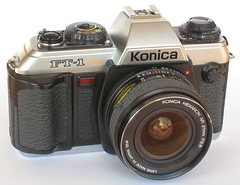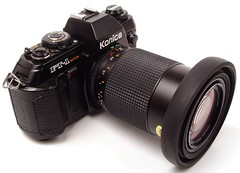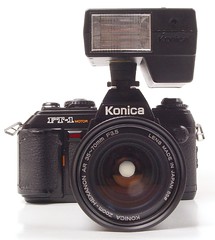Konica FT-1 and FT-1 Pro Half

|
| image by Howard Somerville (Image rights) |
The Konica FT-1 was first offered in 1982, replacing the FS-1 as the company's top-of-the-line, and is considered by many to be the best Konica electronic camera body. Very compact considering its features, it has a nice feel to it and there are chrome and black finished cameras. ALthough much of the exterior is polycarbonates, it is finished in a manner that looks and feels more like earlier, all-metal cameras. Generally speaking, the plastic covers of the camera are actually quite durable.
The FT-1 features a very accurate electronically controlled Copal shutter, very good metering system, built-in film winder (approx. 2 frames per second), and is the only electronic Konica to offer AE Lock. This is whereby light pressure on the shutter release button locks the exposure. It is a convenient method of metering when working with backlit subjects, among other situations.

|
| image by Martin Taylor (Image rights) |
The FT-1 is powered by four AAA alkaline batteries (don't use rechargeable Nicads, they will damage the camera). The batteries fit into the grip on the right front of the camera. Alternatively, a slightly larger AA battery grip is optionally available, and will give more exposures before the batteries are exhausted. The battery compartment/grip is the camera's Achilles Heel. Batteries left inside to leak during storage and contacts damaged while removing or attaching the grip to the camera lead to malfunctions. Spare grip/compartments are getting harder to find.
The ASA setting dial is around the manual film rewind knob on the FT-1. There you will also find a convenient over/under-exposure control. The camera has a built-in self-timer and a bright viewfinder, with LEDs that show exposure information. Exposures may be set manually, or automatically in a shutter preferred fashion (the photographer chooses the shutter speed and the camera sets the correct aperture).

|
| image by Martin Taylor (Image rights) |
The camera also has added flash functions with dedicated units, although it works well with non-dedicated flash, too. Using a dedicated flash, the camera is automatically set to a 1/90 shutter speed. 1/60 is the suggested speed for use with non-dedicated flashes, however many users have successfully used 1/125. Be careful about mounting a heavy flash in the hot shoe on top of the camera. A bump of twist of the flash can crack the polycarbonate top cover of the camera.
On the left front of the camera is an electronic socket. This serves as a means of interfacing with a variety of accessories available for the camera. One is the Konica X36, the largest and most powerful flash Konishiroku offered. Some other accessories that link with the camera via that 5-pin connector are a radio remote control, two different length cable switches and one special dual release for use with a macro Auto Bellows, and an interval timer for time lapse photography.
There is no mirror lockup possible on the FT-1, but the camera is well-damped and shutter shake is not a typical problem at any shutter speed (2 seconds to 1/1000, plus B). Nor is depth-of-field preview possible with this particular camera.
The Konica FT-1 Pro Half (released in 1985) is actually a half frame version of the camera, making 72 exposures, 18mm x 24mm, on what would typically be a 36 exposure roll of film. There aren't a lot of FT-1 Pro Half cameras around, they are considered quite collectible. Most were not sold through retail channels. Instead, they were special gifts for corporate customers and executives. (Note: This is the same as the gold-plated T3N offered some years earlier, another rarity that was given as executive gifts and are now a rare collectible.) Outwardly, the FT-1 Pro Half can only be differentiated from the typical FT-1 by the model name imprinted on the front. All Pro Half are finished in Matte Chrome.
Links
- Konica FT-1 instruction manual at Butkus.org
- Konica FT-1 Motor on www.collection-appareils.fr by Sylvain Halgand (in French)
- JJ's French language page on the Konica FT-1 Motor (archived)